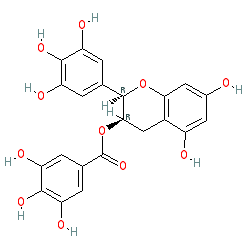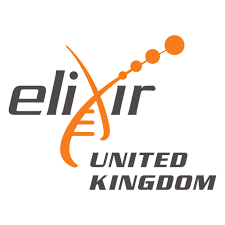|
Abbreviated name: EGCG
Synonyms: EGCG | epigallocatechin gallate
Compound class:
Natural product
Comment: Epigallocatechin-3-gallate (EGCG) is one of the catechins that are found in green tea. It had been ascribed activity as a histone acetyltransferase (HAT) inhibitor. However, a 2017 article by Dahlin et al. suggests that the thiol-reactivity of EGCG brings in to question its activity as a HAT inhibitor [4]. Amongst the plethora of health benefits attributed to the catechins, EGCG has demonstrated broad-spectrum antiviral activity [1,6-9].
SARS-CoV-2 and COVID-19: In relation to SARS-CoV-2, molecular docking analysis suggests that EGCG interacts with the virus' S protein and main protease (Mpro; 3CLpro) [11]. Evidence also suggests that catechins bind to the S1 ubiquitin-binding site of the virus' second protease PLPro. It is hypothesised that inhibiting PLPro will reduce the enzyme's inhibitory function on the host ubiquitin proteasome and interferon stimulated gene systems, thus targeting some of the inflammatory aspects of SARS-CoV-2 infection. Ligand Activity Visualisation ChartsThese are box plot that provide a unique visualisation, summarising all the activity data for a ligand taken from ChEMBL and GtoPdb across multiple targets and species. Click on a plot to see the median, interquartile range, low and high data points. A value of zero indicates that no data are available. A separate chart is created for each target, and where possible the algorithm tries to merge ChEMBL and GtoPdb targets by matching them on name and UniProt accession, for each available species. However, please note that inconsistency in naming of targets may lead to data for the same target being reported across multiple charts. ✖ |
|
|||||||||||||||||||||||||||||||||||
| References |
|
1. Carneiro BM, Batista MN, Braga ACS, Nogueira ML, Rahal P. (2016)
The green tea molecule EGCG inhibits Zika virus entry. Virology, 496: 215-218. [PMID:27344138] |
|
2. Choi KC, Jung MG, Lee YH, Yoon JC, Kwon SH, Kang HB, Kim MJ, Cha JH, Kim YJ, Jun WJ et al.. (2009)
Epigallocatechin-3-gallate, a histone acetyltransferase inhibitor, inhibits EBV-induced B lymphocyte transformation via suppression of RelA acetylation. Cancer Res, 69 (2): 583-92. [PMID:19147572] |
|
3. Chourasia M, Koppula PR, Battu A, Ouseph MM, Singh AK. (2021)
EGCG, a Green Tea Catechin, as a Potential Therapeutic Agent for Symptomatic and Asymptomatic SARS-CoV-2 Infection. Molecules, 26 (5): 1200. [PMID:33668085] |
|
4. Dahlin JL, Nelson KM, Strasser JM, Barsyte-Lovejoy D, Szewczyk MM, Organ S, Cuellar M, Singh G, Shrimp JH, Nguyen N et al.. (2017)
Assay interference and off-target liabilities of reported histone acetyltransferase inhibitors. Nat Commun, 8 (1): 1527. [PMID:29142305] |
|
5. Feki A, Hibaoui Y. (2018)
DYRK1A Protein, A Promising Therapeutic Target to Improve Cognitive Deficits in Down Syndrome. Brain Sci, 8 (10). [PMID:30332747] |
|
6. Ge M, Xiao Y, Chen H, Luo F, Du G, Zeng F. (2018)
Multiple antiviral approaches of (-)-epigallocatechin-3-gallate (EGCG) against porcine reproductive and respiratory syndrome virus infection in vitro. Antiviral Res, 158: 52-62. [PMID:30048655] |
|
7. Lu JW, Hsieh PS, Lin CC, Hu MK, Huang SM, Wang YM, Liang CY, Gong Z, Ho YJ. (2017)
Synergistic effects of combination treatment using EGCG and suramin against the chikungunya virus. Biochem Biophys Res Commun, 491 (3): 595-602. [PMID:28760340] |
|
8. Raekiansyah M, Buerano CC, Luz MAD, Morita K. (2018)
Inhibitory effect of the green tea molecule EGCG against dengue virus infection. Arch Virol, 163 (6): 1649-1655. [PMID:29429035] |
|
9. Reid SP, Shurtleff AC, Costantino JA, Tritsch SR, Retterer C, Spurgers KB, Bavari S. (2014)
HSPA5 is an essential host factor for Ebola virus infection. Antiviral Res, 109: 171-4. [PMID:25017472] |
|
10. Soares S, Silva MS, García-Estevez I, Groβmann P, Brás N, Brandão E, Mateus N, de Freitas V, Behrens M, Meyerhof W. (2018)
Human Bitter Taste Receptors Are Activated by Different Classes of Polyphenols. J Agric Food Chem, 66 (33): 8814-8823. [PMID:30056706] |
|
11. Tallei TE, Tumilaar SG, Niode NJ, Fatimawali, Kepel BJ, Idroes R, Effendi Y, Sakib SA, Emran TB. (2020)
Potential of Plant Bioactive Compounds as SARS-CoV-2 Main Protease (Mpro) and Spike (S) Glycoprotein Inhibitors: A Molecular Docking Study. Scientifica (Cairo), 2020: 6307457. [PMID:33425427] |







